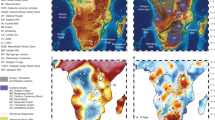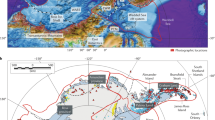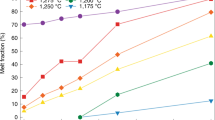Abstract
Areas of exploration for new hydrocarbons are changing as the hydrocarbon industry seeks new resources for economic and political reasons. Attention has turned from easily accessible onshore regions such as the Middle East to offshore continental shelves. Over the past ten years, there has been a marked shift towards deep-water continental margins (500–2,500 m below sea level). In these more hostile regions, the risk and cost of exploration is higher, but the prize is potentially enormous. The key to these endeavours is a quantitative understanding of the structure and evolution of the thinned crust and lithosphere that underlie these margins.
This is a preview of subscription content, access via your institution
Access options
Subscribe to this journal
Receive 51 print issues and online access
$199.00 per year
only $3.90 per issue
Buy this article
- Purchase on Springer Link
- Instant access to full article PDF
Prices may be subject to local taxes which are calculated during checkout







Similar content being viewed by others
References
C. Kuykendall . M. K. Hubbert and his Heirs: A Hubbert Peak Half-Biographraphy at 〈http://www.oilcrisis.com/library/hubheir.pdf〉 (2003).
The Association for the Study of Peak Oil & Gas 〈http://www.peakoil.net〉
Parrish, J. T. Palaeo-upwelling and the Distribution of Organic-Rich Rocks. 199–205 (Spec. Publ. 26, Geol. Soc. Lond., 1987).
Milliman, J. D. & Syvitski, J. P. M. Geomorphic tectonic control of sediment discharge to the oceanó the importance of small mountainous rivers. J. Geol. 100, 525–544 (1992).
Kuenen, P. H. & Migliorini, C. Tubidity currents as a cause of graded bedding. J. Geol. 58, 91–127 (1950).
Douglas-Westwood & Infield Systems. The World Deep-Water Report IV 2003-2007 at 〈http://www.infield.com/Deepwater-Report2003-2007.html〉 (2003).
Steckler, M. S. & Watts, A. B. Subsidence of the Atlantic continental margin off New York. Earth Planet. Sci. Lett. 41, 1–13 (1978).
McKenzie, D. P. Some remarks on the development of sedimentary basins. Earth Planet. Sci. Lett. 40, 25–32 (1978).
Le Pichon, X. & Sibuet, J.-C Passive margins: a model of formation. J. Geophys. Res. 86, 3708–3720 (1981).
Louden, K. E., Sibuet, J.-C & Foucher, J.-P Variations in heat flow across the Goban Spur and Galicia Bank continental margins. J. Geophys. Res. 96, 16131–16150 (1991).
Louden, K. E., Sibuet, J.-C & Harmegnies, F. Variations in heatflow across the ocean-continent transition in the Iberian abyssal plain. Earth Planet. Sci. Lett. 151, 233–254 (1997).
Foucher, J. P. et al. Heatflow in the Valentia Trough: geodynamic implications. Tectonophysics 203, 77–97 (1992).
White, R. S. & McKenzie, D. Magmatism at rift zones: the generation of volcanic continental margins and flood basalts. J. Geophys. Res. 94, 7685–7729 (1989).
Holbrook,W. S. et al. Mantle thermal structure and active upwelling during continental break-up in the North Atlantic. Earth Planet. Sci. Lett. 190, 251–266 (2001).
Nottvedt, A. et al. Dynamics of the Norwegian Continental margin. (Spec. Pub., Geol. Soc. Lond., 2000).
Louden, K. E. & Chian, D. The deep structure of non-volcanic rifted continental margins. Phil. Trans. R. Soc. Lond. 357, 767–805 (1999).
Whitmarsh, R. B., Manatschal, G. & Minshull, T. A. Evolution of magma-poor continental margins from rifting to sea-floor spreading. Nature 413, 150–155 (2001).
Minshull, T. A. The break-up of continents and the formation of new ocean basins. Phil. Trans. R. Soc. Lond. 360, 2839–2852 (2002).
Bown, J. W. & White, R. S. in Rifted Ocean-Continent Boundaries (eds Banda, E., Torné, M. & Talwani, M.)(Kluwer, Dordrecht, 1995).
Chian, D. & Louden, K. E. Crustal structure of the Labrador Sea conjugate margin and implications for the formation of non-volcanic continental margins. J. Geophys. Res. 100, 24239–24253 (1995).
Holbrook, W. S. & Kelemen, P. B. Large igneous province on the US Atlantic margin and implications for magmatism during continental breakup. Nature 364, 433–364 (1993).
Bauer, K. et al. Deep structure of the Namibia continental margin as derived from integrated geophysical studies. J. Geophys. Res. 105, 25829–25853 (2000).
Watts, A. B. & Stewart, J. Gravity anomalies and segmentation of the continental margin offshore West Africa. Earth Planet. Sci. Lett. 156, 239–252 (1998).
Haines, A. J. & Holt, W. E. A procedure for obtaining the complete horizontal motions within zones of distributed deformation from the inversion of strain rate data. J. Geophys. Res. 98, 12057–12082 (1993).
Holt, W. E., Chamot-Rooke, N., Le Pichon, X., Haines, A. J., Shen-Tu, B. & Ren, J. The velocity field in Asia inferred from Quaternary fault slip rates and GPS observations. J. Geophys. Res. 105, 19185–19210 (2000).
Bassi, G. Relative importance of strain rate and rheology for the mode of continental extension. Geophys. J. Int. 122, 195–210 (1995).
Newman, R. & White, N. The dynamics of extensional sedimentary basins: constraints from subsidence inversion. Phil. Trans. R. Soc. Lond. 357, 805–830 (1999).
White, N. An inverse method for determining lithospheric strain rate variation on geological timescales. Earth Planet. Sci. Lett. 122, 351–371 (1994).
Bellingham, P. & White, N. A general inverse method for modelling extensional sedimentary basins. Basin Res. 12, 219–226 (2000).
White, N. & Bellingham, P. A. Two-dimensional inverse model for extensional sedimentary basins: 1. Theory. J. Geophys. Res. 107, doi10.1029/2001JB000173 (2002).
Davis, M. & Kusznir, N. Are buoyancy forces important during the formation of rifted margins? Geophys. J. Int. 149, 524–533 (2002).
Kreemer, C., Haines, J., Holt, W. E., Blewitt, G. & Lavalle, D. On the determination of a global strain rate model. Earth Planets Space 52, 765–770 (2000).
Burnham, A. K. & Sweeney, J. J. A chemical kinetic model of vitrinite maturation and reflectance. Geochim. Cosmo. Acta 53, 2649–2657 (1989).
Marton, L. G., Tari, G. C. & Lehmann, C. T. in Atlantic Rifts and Continental Margins Geophys. Monogr. 115 (eds W. Mohriak & M. Talwani) (Am. Geophys. Union, 2000).
Wessel P. & Smith W. H. F. New version of the Generic Mapping Tools released. Eos 76, 329 (1995).
Malvern, L. E. Introduction to the Mechanics of a Continuous Medium (Prentice-Hall, Old Tappan, NJ, 1969).
England, P. & McKenzie, D. A thin viscous sheet model for continental deformation. Geophys. J. R. Astron. Soc. 70, 295–321 (1982).
Beavan, J. & Haines, J. Contemporary horizontal velocity and strain rate fields of the Pacific-Australian plate boundary zone through New Zealand. J. Geophys. Res. 106, 741–770 (2001).
Lucazeau, F. & Le Douaran, S. The blanketing effect of sediments in basins formed by extension: a numerical model. Application to the Gulf of Lion and Viking Graben. Earth Planet. Sci. Lett. 74, 92–102 (1985).
Gallagher, K., Ramsdale, M., Lonergan, L. & Morrow, D. The role of thermal conductivity measurements in modelling thermal histories in sedimentary basins. Mar. Petrol. Geol. 14, 201–214 (1997).
Zoeppritz, K. Erdbebenwellen VIII B, Uber Reflexion und durchgang seismischer wellen durch unStetigkeitsflachen. Gottinger Nachr. 1, 66–84 (1919).
Aki, K. I. & Richards, P. G. Quantitative Seismology (W.H. Freeman, New York, 1980).
Shuey, R. T. A simplification of the Zoeppritz equations. Geophysics 50, 609–614 (1985).
Gassmann, F. Uber die Elastizitat poroser Medien. Veirteljahr Naturforsch Gese. Zurich 96, 1–23 (1951).
Rutherford, S. R. & Williams, R. H. Amplitude-versus-offset variations in gas sands. Geophysics 54, 680–688 (1989).
Pegrum, R. M., Odegard, T., Bonde, K. & Hamann, N. E. Exploration in the Fylla area, SW Greenland. Am. Assoc. Petrol. Geol. (Regional Conference St Petersburg, 15–18 July, 2001).
Acknowledgements
We thank K. Gallagher for peer review. S. Jones allowed us to show his unpublished basin animations (Fig. 5). A. Butler, R. Hardy, S. Jones, G. Kirby, D. Lyness, B. Lovell, M. Mayall, T. Minshull and J.-C. Sempere provided substantial help. We are grateful to BP, Sonangol and partners for permission to publish this paper and especially the seismic section and amplitude maps of Fig. 7. Some figures were prepared using GMT.
Author information
Authors and Affiliations
Corresponding author
Rights and permissions
About this article
Cite this article
White, N., Thompson, M. & Barwise, T. Understanding the thermal evolution of deep-water continental margins. Nature 426, 334–343 (2003). https://doi.org/10.1038/nature02133
Issue Date:
DOI: https://doi.org/10.1038/nature02133
This article is cited by
-
A Short Walk through Gravity Studies at CSIR-NGRI, India
Journal of the Geological Society of India (2021)
-
Anomalous heat flow belt along the continental margin of Brazil
International Journal of Earth Sciences (2018)
-
Characterization of fluoride-tolerant halophilic Bacillus flexus NM25 (HQ875778) isolated from fluoride-affected soil in Birbhum District, West Bengal, India
Environmental Monitoring and Assessment (2014)
-
Analyses on the tectonic thermal evolution and influence factors in the deep-water Qiongdongnan Basin
Acta Oceanologica Sinica (2014)
Comments
By submitting a comment you agree to abide by our Terms and Community Guidelines. If you find something abusive or that does not comply with our terms or guidelines please flag it as inappropriate.



